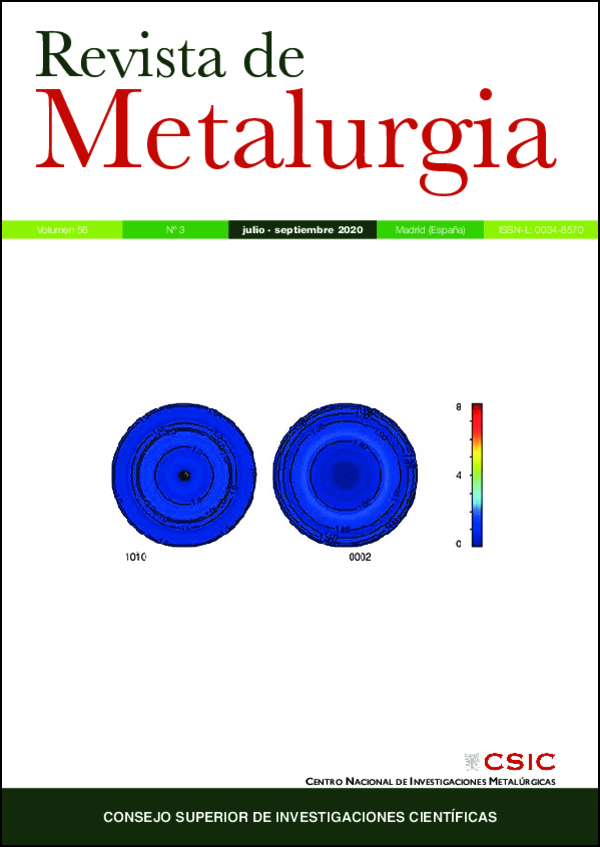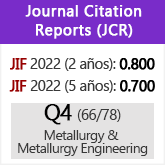La eliminación de metales tóxicos presentes en efluentes líquidos mediante resinas de cambio iónico. Parte XIII: Zinc(II)/H+/Lewatit OC-1026
DOI:
https://doi.org/10.3989/revmetalm.172Palabras clave:
Efluentes líquidos, Eliminación, Lewatit OC-1026, Nanotubos de carbono de pared múltiple, Zinc(lI)Resumen
La resina de intercambio catiónico Lewatit OC-1026 (que tiene como grupo activo al acido di-2-etilhexil fosfórico adsorbido) se ha utilizado para la eliminación de zinc(II) de disoluciones acuosas. Esta eliminación se ha investigado bajo diferentes condiciones experimentales: velocidad de agitación (400-1200 min−1), temperatura (20-60 °C), pH del medio acuoso (1-4) y concentración de la resina (0,05-0,4 g·L−1). La carga de zinc(II) en la resina disminuye con el aumento de la temperatura (reacción exotérmica) en un proceso espontaneo, alcanzándose el equilibrio en tiempos mas cortos al aumentar esta variable. A 20 °C, los datos experimentales se ajustan a la cinética de pseudo-segundo orden, mientras que a 60 °C el modelo cinético que mejor representa la carga del metal en la resina es el de segundo orden. El proceso de cambio iónico depende del valor de pH del medio acuoso, disminuyendo el tanto por ciento de la carga del metal en la resina con la disminución de este valor (de 4 a 1); a pH 4, la carga del metal responde al modelo de difusión en la partícula y a la isoterma tipo-2 de Langmuir. La resina Lewatit OC-1026 presenta mejores características, respecto a la eliminación de zinc(II), que los nanotubos de carbono funcionarizados (grupos carboxílicos) y sin funcionalizar. El zinc(II) cargado en la resina puede ser eluido mediante el uso de disoluciones ácidas.
Descargas
Citas
Abdelrahman, E.A., Tolan, D.A., Nassar, M.Y. (2019). A tunable template-assisted hydrothermal synthesis of hydroxysodalite zeolite nanoparticles using various aliphatic organic acids for the removal of zinc(II) ions from aqueous media. J. Inorg. Organomet. Polym. Mater. 29, 229-247. https://doi.org/10.1007/s10904-018-0982-9
Abd El Salam, H.M., Zaki, T. (2019). A novel microwave synthesis of manganese based MOF for adsorptive of Cd(II), Pb(II) and Hg(II) ions from aqua medium. Egyptian J. Chem. 62, 1237-1251. https://doi.org/10.21608/ejchem.2019.6524.1550
Ahmad, S.Z.N., Wan Salleh, W.N., Ismail, A.F., Yusof, N., Mohd Yusop, M.Z., Aziz, F. (2020). Adsorptive removal of heavy metal ions using graphene-based nanomaterials: Toxicity, roles of functional groups and mechanisms. Chemosphere 248, 126008. https://doi.org/10.1016/j.chemosphere.2020.126008 PMid:32006836
Alguacil, F.J., Coedo, A.G., Dorado, T., Padilla, I. (2002). The removal of toxic metals from liquid effluents by ion exchange resins. Part I: chromium(VI)/sulphate/Dowex 1×8. Rev. Metal. 38 (4), 306-311. https://doi.org/10.3989/revmetalm.2002.v38.i4.412
Alguacil, F.J. (2002). The removal of toxic metals from liquid effluents by ion exchange resins. Part II: cadmium(II)/sulphate/Lewatit TP260. Rev. Metal. 38 (5), 348-352. https://doi.org/10.3989/revmetalm.2002.v38.i5.418
Alguacil, F.J. (2003). The removal of toxic metals from liquid effluents by ion exchange resins. Part III: copper(II)/sulphate/Amberlite 200. Rev. Metal. 39 (3), 205-209. https://doi.org/10.3989/revmetalm.2003.v39.i3.330
Alguacil, F.J. (2017a). The removal of toxic metals from liquid effluents by ion exchange resins. Part IV: chromium(III)/H+/Lewatit SP112. Rev. Metal. 53 (2), e093.
Alguacil, F.J. (2017b). The removal of toxic metals from liquid effluents by ion exchange resins. Part V: nickel(II)/H+/Dowex C400. Rev. Metal. 53 (4), e105.
Alguacil, F.J., Garcia-Diaz, I., Lopez, F., Rodriguez, O. (2017). Removal of Cr(VI) and Au(III) from aqueous streams by the use of carbon nanoadsorption technology. Desal. Water Treat. 63, 351-356. https://doi.org/10.5004/dwt.2017.0264
Alguacil, F.J. (2018a). The removal of toxic metals from liquid effluents by ion exchange resins. Part VI: manganese(II)/H+/Lewatit K2621. Rev. Metal. 54 (2), e116.
Alguacil, F.J. (2018b). The removal of toxic metals from liquid effluents by ion exchange resins. Part VII: manganese(VII)/H+/Amberlite 958. Rev. Metal. 54 (3), e125.
Alguacil, F.J., Escudero, E. (2018). The removal of toxic metals from liquid effluents by ion exchange resins. Part VIII: arsenic(III)/OH−/Dowex 1×8. Rev. Metal. 54 (4), e132.
Alguacil, F.J. (2019a). The removal of toxic metals from liquid effluents by ion exchange resins. Part IX: lead(II)/H+/Amberlite IR120. Rev. Metal. 55 (1), e138.
Alguacil, F.J. (2019b). The removal of toxic metals from liquid effluents by ion exchange resins. Part X: antimony(III)/H+/Ionac SR7. Rev. Metal. 55 (3), e152.
Alguacil, F.J. (2019c). The removal of toxic metals from liquid effluents by ion exchange resins. Part XI: cobalt(II)/H+/Lewatit TP260. Rev. Metal. 55 (4), e154.
Alguacil, F.J., Escudero, E. (2020). The removal of toxic metals from liquid effluents by ion exchange resins. Part XII: mercury(II)/H+/Lewatit SP112. Rev. Metal. 56 (1), e160.
Alguacil, F.J., López, F.A., Rodriguez, O., Martinez-Ramirez, S., Garcia-Diaz, I. (2016). Sorption of indium (III) onto carbon nanotubes. Ecotox. Environ. Safe. 130, 81-86. https://doi.org/10.1016/j.ecoenv.2016.04.008 PMid:27085001
Aliyu, A. (2019). Synthesis, electron microscopy properties and adsorption studies of Zinc (II) ions (Zn2+) onto as-prepared Carbon Nanotubes (CNTs) using Box-Behnken Design (BBD). Sci. African 3, e00069. https://doi.org/10.1016/j.sciaf.2019.e00069
Chasapis, C.T., Loutsidou, A.C., Spiliopoulou, C.A., Stefanidou, M.E. (2012). Zinc and human health: an update. Arch. Toxicol. 86, 521-534. https://doi.org/10.1007/s00204-011-0775-1 PMid:22071549
Chen, Y., Zhao, H., Li, Y., Zhao, W., Yang, X., Meng, X., Wang, H. (2019). Two-step preparation of an amidoxime-functionalized chelating resin for removal of heavy metal ions from aqueous solution. J. Chem. Eng. Data 64, 4037-4045. https://doi.org/10.1021/acs.jced.9b00402
Gümüş, D. (2019). Biosorptive application of defatted Laurus nobilis leaves as a waste material for treatment of water contaminated with heavy metal. Int. J. Phytoremediat. 21 (6), 556-563. https://doi.org/10.1080/15226514.2018.1537254 PMid:30729808
Ho, Y.-S. (2006). Review of second-order models for adsorption systems. J. Hazard. Mater. 136 (3), 681-689. https://doi.org/10.1016/j.jhazmat.2005.12.043 PMid:16460877
López Díaz-Pavón, A., Cerpa, A., Alguacil, F.J. (2014). Processing of indium(III) solutions via ion exchange with Lewatit K-2621 resin. Rev. Metal. 50 (2), e010. https://doi.org/10.3989/revmetalm.010
Maret, W. (2013). Zinc and human disease. In: Interrelations between Essential Metal Ions and Human Diseases. Sigel A., Sigel, H., Sigel, R. (Eds), Met. Ions Life Sci. Vol 13. Springer, Dordrecht, pp. 389-414. https://doi.org/10.1007/978-94-007-7500-8_12 PMid:24470098
Mirjavadi, E.S., Tehrani, R.M.A., Khadir, A. (2019). Effective adsorption of zinc on magnetic nanocomposite of Fe3O4/zeolite/cellulose nanofibers: kinetic, equilibrium, and thermodynamic study. Environ. Sci. Pollut. Res. 26, 33478-33493. https://doi.org/10.1007/s11356-019-06165-z PMid:31529345
Sakalova, H., Malovanyy, M., Vasylinycz, T., Palamarchuk, O., Semchuk, J. (2019). Cleaning of Effluents from Ions of Heavy Metals as Display of Environmentally Responsible Activity of Modern Businessman J. Ecol. Eng. 20 (4), 167-176. https://doi.org/10.12911/22998993/102841
Walker Jr., L. (2020). Clean Water Act (CWA) Alternate Test Procedures (ATP) (personal communication to F.J.A. 19/02/2020). U.S. Environmental Protection Agency (EPA). https://www.epa.gov/cwa-methods/alternate-test-procedures.
WHO (2020). Zinc in drinking-water. World Health Organization (accessed February 2020). https://www.who.int/water_sanitation_health/dwq/chemicals/zinc.pdf.
Wieszczycka, K., Filipowiak, K., Aksamitowski, P., Wojciechowska, I. (2020). Task-specific ionic liquid impregnated resin for zinc(II) recovery from chloride solutions. J. Molec. Liq. 299, 112115. https://doi.org/10.1016/j.molliq.2019.112115
Zand, A.D., Abyaneh, M.R. (2019). Equilibrium and kinetic studies in remediation of heavy metals in landfill leachate using wood-derived biochar. Desalin. Water Treat. 141, 279-300. https://doi.org/10.5004/dwt.2019.23571
Zhang, Q., Hou, Q., Huang, G., Fan, Q. (2020). Removal of heavy metals in aquatic environment by graphene oxide composites: a review. Environ. Sci. Pollut. Res. 27, 190-209. https://doi.org/10.1007/s11356-019-06683-w PMid:31838692
Publicado
Cómo citar
Número
Sección
Licencia
Derechos de autor 2020 Consejo Superior de Investigaciones Científicas (CSIC)

Esta obra está bajo una licencia internacional Creative Commons Atribución 4.0.
© CSIC. Los originales publicados en las ediciones impresa y electrónica de esta Revista son propiedad del Consejo Superior de Investigaciones Científicas, siendo necesario citar la procedencia en cualquier reproducción parcial o total.Salvo indicación contraria, todos los contenidos de la edición electrónica se distribuyen bajo una licencia de uso y distribución “Creative Commons Reconocimiento 4.0 Internacional ” (CC BY 4.0). Puede consultar desde aquí la versión informativa y el texto legal de la licencia. Esta circunstancia ha de hacerse constar expresamente de esta forma cuando sea necesario.
No se autoriza el depósito en repositorios, páginas web personales o similares de cualquier otra versión distinta a la publicada por el editor.


















